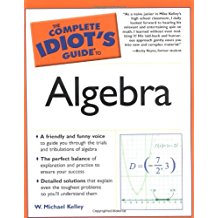Algebra: Get Your Operations in Order
Get Your Operations in Order
If I asked you to evaluate the expression 4 + 5 · 2, what answer would you give? Most new algebra students answer 18, but the correct answer is actually 14. Math isn't like readingyou don't always perform the operations in an expression left to right. Instead, the order you take depends upon the operations themselves. For example, you should always perform multiplication before addition, so in the expression 4 + 5 · 2, you should multiply to get 10 and then add the 4, which is where the correct answer of 14 comes from. Here's the exact order you should follow when evaluating expressions:
- Parentheses (or other grouping symbols): If there's more than one set of grouping symbols, work from the inside out.
- Exponents: Evaluate any powers in the expression.
- Multiplication and Division: These operations get done in the same step; neither one takes precedence. If there are multiple examples of one or either operation, work from left to right.
- Addition and Subtraction: Again, these operations are done in the same step; if necessary, work left to right just like you did with multiplication and division.
You may have heard the mnemonic phrase "Please excuse my dear Aunt Sally" used to help remember the order of operations. Each letter in the phrase matches the first letter in the correct order of operations. However, it confuses come students, who see "m" come before "d" in the phrase and assume that multiplication always comes before division, and that's not truethey're done in the same step from left to right, as I mentioned. If you keep that in mind, however, it's a very handy phrase. If the Aunt Sally phrase is too outdated or lame for you, try "Poetic elephants might dream about sonnets" or "Penguins eat my dad's athletic socks."
Kelley's Cautions
Example 5(c) teaches an important lesson. In the expression -an, only a is raised to the n power, but in (-a)n it's -a that's raised to the power.
You've Got Problems
Problem 6: Simplify the expression 102 · 52 · 3.
Example 6: Simplify the expressions.
- (a) 1 + 10 · (4 - 2)
- Solution: Parentheses come first, so subtract 2 from 4.
- 1 + 10 · 2
- All that's left is addition and division, and according to the order of operations, division comes first.
- 1 + 5 = 6
- (b) 6 - [(12 + 3) · 5 + 1]
- Solution: There are two sets of grouping symbols, so start with the innermost set, the parentheses, first.
- 6 - [15 · 5 + 1]
- You've still got brackets left, so simplify them, making sure to do division before addition. (The order of operations still applies inside those brackets.)
- 6 - [3 + 1] = 6 - 4 = 2
- (c) -32
- Solution: Let me warn youthis is kind of tricky, because most people assume that -32 is the same as (-3)2, and it's not. The expression (-3)2 translates into "-3 to the second power" or (-3)(-3), which equals a positive 9.
- The other expression, -32, means "the opposite of 3 squared." Since 32 = 9, then -32 = -9.

Excerpted from The Complete Idiot's Guide to Algebra © 2004 by W. Michael Kelley. All rights reserved including the right of reproduction in whole or in part in any form. Used by arrangement with Alpha Books, a member of Penguin Group (USA) Inc.
You can purchase this book at Amazon.com and Barnes & Noble.







